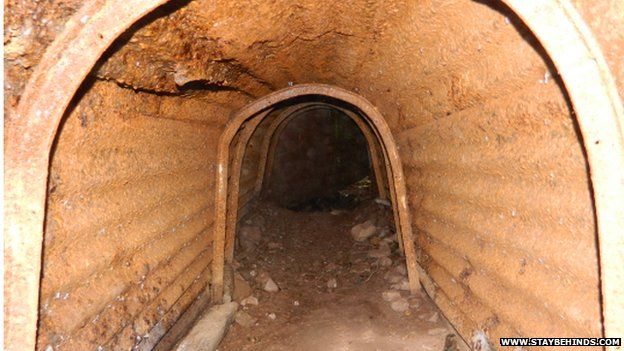Unearthing the deadly Dad’s Army
- Published

The story of how Britain prepared for the threat of Nazi occupation in World War Two is quite literally being unearthed by researchers. They have been uncovering hidden operational bases for resistance fighters, most recently near the town of Selkirk in the Scottish Borders.
Hidden somewhere in the UK countryside near you - or under you - lie buried hundreds of bunkers, built in utmost secrecy on the orders of Winston Churchill during WW2, where the British resistance would wage guerrilla warfare against a Nazi occupation.
If the invasion alarm sounded, a network of 3,000 volunteers were ready to go to ground in smugglers' caves, coal mines and even 2,000-year-old Pictish chambers, to form Britain's last ditch line of defence.
So hush-hush was the British Resistance Organisation's membership, and so ingeniously concealed were their 500 foxholes, that many have yet to be identified by researchers, 70 years after Victory in Europe, or VE Day.
But VE Day seemed very far away five years earlier in 1940 as Hitler's army forced the retreat of 330,000 Allied soldiers from Dunkirk.
Now alone in battle, Churchill drew up plans for an imminent Nazi invasion.
Across Britain, intelligence officers recruited and trained local cells of civilian saboteurs and assassins.
The "auxiliary units" of between four and eight men were picked from the cream of the Home Guard, where they would wait silently under cover for the call to take up arms underground in the hills and forests near strategic roads and railways.
"When the bells rang - which was the warning sign - members would slip out of their houses, with no chance to say goodbye to anyone," explains David Blair, who is researching Scotland's units for the Coleshill Auxiliary Research Team (CART) - named after the resistance's training school in England.
"They would then equip, regroup, and get to their underground base."
Royal Engineers dug tunnels and rooms in total darkness, and discretely disposed of thousands of tonnes of earth, to evade the attention of their own countrymen.
The entrances and emergency escape hatches were so well camouflaged, hundreds have been walked over unnoticed for the past 75 years.
'Operational patrols'
From here the "operational patrols", composed of seemingly innocent folk by day such as gardeners, carpenters, plumbers, doctors, farmers, gamekeepers and even Olympic sportsmen, would plot daring night raids to harass and kill Britain's occupiers.
The British High Command had analysed the enemy's tactics in Europe, and decided the best way to overcome them was to deny their mobility and disrupt their vital supply lines.
Inside each buried hideout, termed an "operational base" or OB to avoid arousing local or Nazi suspicions, would be an arsenal of silenced pistols, plastic explosives, submachine guns, commando knives and food and water lasting up to a month.
Local spy rings called the Special Duties Branch, totalling 4,000 informants nationwide, were set up to act as the combat units' eyes and ears above ground, relaying intelligence on the number and movements of German divisions, vehicles and high-ranking officers.
Utter secrecy was key to protecting the networks: partisans were expected to shoot themselves first rather than be taken alive.
Each volunteered knowing they'd be shot, if captured. "They knew they could be killed," Mr Blair claims, "and the Nazis would hang and execute civilians in retribution for their losses."
For over half a century, the deadly Dad's Army remained one of WW2's best-kept secrets.
But now the British Resistance Archive is seeking to identify our operational patrols to honour their bravery.
Seven decades on, its researchers are still unearthing hidden operational bases that have survived destruction and decay - most recently near the town of Selkirk, which hid just one of the 21 patrols along the English-Scottish border.
The historically sensitive site's exact location is still secret, but it lurks high in woods close to the Waverley Railway line - a likely target for the local patrol to blow up.
'Tutankhamun's tomb'
Its two discoverers - David Blair and a retired policeman - recorded on the archive's website that once they had shimmied down the narrow, daunting entrance shaft into "inky blackness", the bunker was found in "a very good state of preservation".
It opened up into an arched chamber of standing height, adorned with cables for internal lighting, bunk beds, a fire, fresh water tank and ventilation pipes.
"It was like coming into Tutankhamun's tomb," Mr Blair says.
"The construction and use of material is impressive," he explains, "and the layout and design of this OB utilised a few thousand bricks used during its construction, as well as the corrugated sheeting, which would have needed a good cover story for any nosey locals."
Nearby in Newtown St Boswells two years ago, the pair found another dugout still with its chemical toilet and escape tunnel.
Earlier this year in Dumfries and Galloway, an even more extensive bunker was identified with a stove and bunk beds near Moffat.
Galashiels' OB is next on his list to find.
After 20 years of research, David now believes he knows the name of every member of Scotland's 100 patrols.
Selkirk's auxiliary unit, just like Dad's Army in the BBC comedy sitcom, was also led by a bank manager, but he was named Sgt J Allen rather than Capt Mainwaring.
There was a J Walker in his platoon too: a corporal who was Sgt Allen's second-in-command.
Out of the 3,000 members of the British Resistance, Mr Blair estimates 650 belonged to patrols in Scotland.
"(They were) men who by day farmed the land, tended the sheep or managed industry," he writes, "and come the invasion would have slipped into that dark night, possibly never to be seen again.
"We should give them the recognition they deserve."
The British Resistance Archive is keen to collect any information before it is too late, and invites anyone who can help to get in touch via their website: www.coleshillhouse.com.